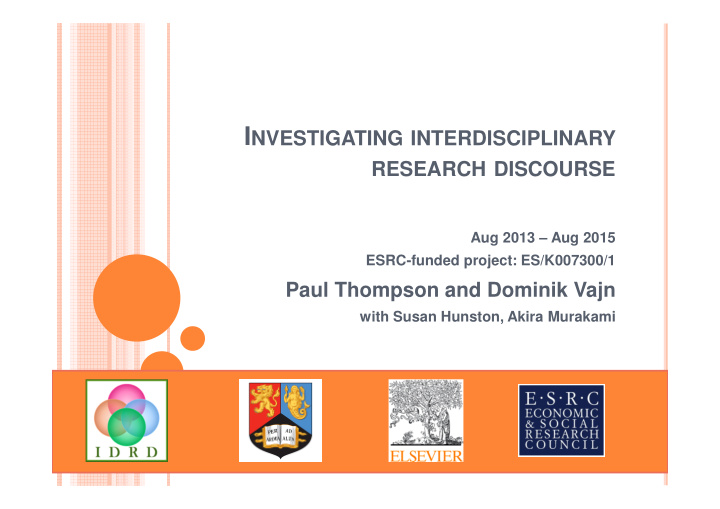



I NVESTIGATING INTERDISCIPLINARY RESEARCH DISCOURSE Aug 2013 – Aug 2015 ESRC-funded project: ES/K007300/1 Paul Thompson and Dominik Vajn with Susan Hunston, Akira Murakami
M AIN AIM � to achieve a fuller understanding of the distinctive features of discourse practices in interdisciplinary research and of how they differ from discourse practices in conventional disciplines Global Environmental Change – a successful interdisciplinary journal published by Elsevier
B ROAD QUESTIONS � To what extent does the field of ‘global environmental change’ operate as a unified whole? � Do authors in the field broaden their messages to a multidisciplinary audience, or do they write in the same way that they would if they were writing for a monodisciplinary audience?
D ATA � * Full holdings of a successful IDR journal, Global Environmental Change, 1990-2010 � 676 articles � * Samples from 5 IDR journals and 5 specialist journals, 2001-2010 � Surveys, interviews with editors, board members, authors
S ELECTION PROCEDURE � Scopus (abstract and citation database of peer- reviewed literature) � GEC is associated with: � Ecology; � Global and Planetary Change; � Management, Monitoring, Policy and Law; � Geography, Planning and Development � Observation: � many articles in GEC deal with social policy and with international relations; � only about 20 percent of the articles have mathematical equations and other symbolic formulae in them
Journals with connections to journals which are themselves well- connected to one another are said to have a high clustering coefficient Look for monodisciplinary journals with a high clustering coefficient, and multidisciplinary journals with a low clustering coefficient.
��������������������������� Sketch ������������������������������ Engine
explore find In this paper – a key trigram for GEC argue confirm discuss reveal T HIS PAPER VS T HIS STUDY outline indicate 0% 10% 20% 30% 40% 50% 60% 70% 80% 90% 100% AEE B CEUS EP GEC this paper this study JRS AWR JSIS PS REE TRTE
������������������� ������ ������� ���������� ��!�������� ����"������� ������!�#���$%���
Multidisciplinary journals 7K 6K 5K 4K
Similarity of linguistic profile between EP and PS: one multidisciplinary, the other monodisciplinary
G LOBAL E NVIRONMENTAL C HANGE (GEC)
A BOUT THE J OURNAL � Total number of papers: 676 � Range: 1990/1 - 2010 � All original research articles (Scopus)
G LOBAL E NVIRONMENTAL C HANGE
H OWEVER … � 107 papers were non-research articles (mainly viewpoint articles) � 569 papers used in labelling � only 434 used in multi-dimensional analysis, as papers needed to be >2000 words
P ROJECT C ORPUS
INTERDISCIPLINARITY
INTERDISCIPLINARITY
INTERDISCIPLINARITY
I NTERDISCIPLINARITY IN GEC ske.li/interdisciplinary
N UMBER OF AUTHORS � Collaboration between disciplines implies that papers should generally be multi-authored � Multinational, collaborative, cooperative, intergovernmental – all imply multiple parties
N UMBER OF A UTHORS
P ROPORTION OF AUTHORS
N UMBER OF AUTHORS � Single authorship is predominant in early years � Increase in multiple authors is a general trend in all disciplines (Elsevier)
P APER LABELLING
L ABELLING � Initial categories: � Issues � Policy discussion � Quantitative empirical study and modelling � Qualitative study � Research agenda � Research framework � Other
55% AGREEMENT � � � �
S ECOND CATEGORISATION � 4 categories: � Empirical � Research agenda and frameworks � Policy discussion � Other
66%-85% AGREEMENT � � � �
L ABELLING � Analysed 400 papers � 169 to go � Covering the whole 20 year period
P APER TYPES PER YEAR 18 16 14 12 10 8 6 4 2 0 1991 1992 1993 1994 1995 1996 1997 1998 1999 2000 2001 2002 2003 2004 2005 2006 2007 2008 2009 2010 Empirical Other Policy Agenda
L ABELLING � Early years agenda setting � Defining the journal’s purpose and goals � Kyoto protocol – increase in policy papers � The notion of vulnerability – discussed in 2003 and redefined in 2007
L ABELLING � The increase in agenda and policy papers is marked by a decrease in empirical papers � However, setting out the agenda is followed by an increase in empirical papers
P APER TYPES PER YEAR 18 16 14 12 10 8 6 4 2 0 1991 1992 1993 1994 1995 1996 1997 1998 1999 2000 2001 2002 2003 2004 2005 2006 2007 2008 2009 2010 Empirical Other Policy Agenda
C ONCLUSION � not labels to categorise all the types of academic papers � rather a useful framework for our analysis � based on the types of papers included in the GEC
T O FOLLOW THE IDRD PROJECT � Visit: � www.idrd-bham.info � Or: � @IDRD_bham
Recommend
More recommend